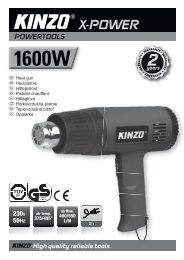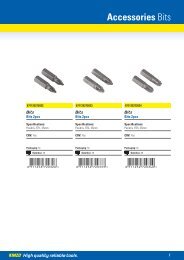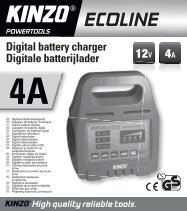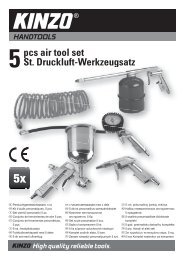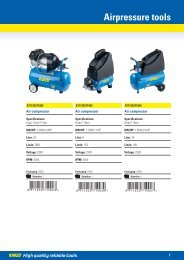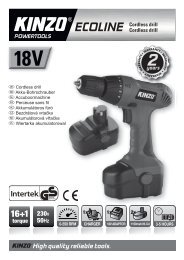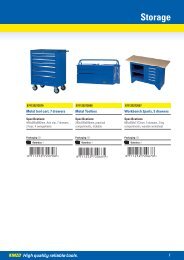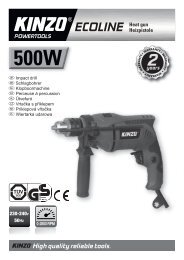ECOLINE Jig saw - kinzo
ECOLINE Jig saw - kinzo
ECOLINE Jig saw - kinzo
You also want an ePaper? Increase the reach of your titles
YUMPU automatically turns print PDFs into web optimized ePapers that Google loves.
A<br />
General<br />
Never use a blade unsuitable for the task and item to be cut.<br />
Hold the <strong>saw</strong> in front of you with a firm grip on the handle.<br />
Ensure that the <strong>saw</strong> blade is not touching anything and that the power cable is not in the way when starting<br />
the <strong>saw</strong>.<br />
Make sure that the item is clamped tight, and that the <strong>saw</strong> line is clearly marked.<br />
Connect the vacuum extractor nozzle to an extractor system where possible.<br />
Start the <strong>saw</strong>. Place the soleplate on the item, and let the <strong>saw</strong> blade touch the <strong>saw</strong> line.<br />
Saw, but do not place more pressure on the blade than is necessary. Avoid lateral pressure on the blade.<br />
Special notes on jig <strong>saw</strong>ing<br />
Place the soleplate on the item so the <strong>saw</strong> blade is vertical and correctly positioned in relation to the <strong>saw</strong> line<br />
without touching it.<br />
Start the <strong>saw</strong> and tilt it carefully while supporting it using the soleplate until the blade touches the item at<br />
the <strong>saw</strong> line.<br />
Let the blade work through the item, continuing to tip the <strong>saw</strong> downwards until the sole is flush to the item<br />
and the blade is perpendicular to it. If necessary, drill a hole of suitable diameter in the item for use as starting<br />
point.<br />
Sawing wood<br />
Check that the item does not contain nails or other metal objects. Always wear a mask.<br />
Sawing metal<br />
We recommend lubricating the material and <strong>saw</strong> blade with cutting oil to protect the tool and avoid overheating.<br />
Support the item with wooden blocks on either side.<br />
Sawing plastic<br />
Make a test cut first to check if the material can tolerate the heat generated by <strong>saw</strong>ing.<br />
Important!<br />
Check all screws on the <strong>saw</strong> regularly, particularly those that hold the blade. Tighten if required.<br />
Check regularly that the carbon brushes are in a good condition. If the carbon brushes are worn,<br />
they should be replaced.<br />
Lubrication (Fig. 2)<br />
Regularly apply a drop of oil to lubricate the guide roller (7).<br />
Cleaning and maintenance<br />
Wipe the <strong>saw</strong> using a well-wrung cloth after use, and always keep the surface and ventilation holes free of<br />
dirt. Keep the soleplate free of dirt to avoid the <strong>saw</strong> cutting incorrectly.<br />
Never use corrosive or abrasive cleaning agents, as they may attack the plastic parts of the <strong>saw</strong>.<br />
Recycling<br />
Meaning of crossed –out wheeled dustbin:<br />
Do not dispose of electrical appliances as unsorted municipal waste, use separate collection facilities.<br />
Contact you local government for information regarding the collection systems available. If<br />
electrical appliances are disposed of in landfills or dumps, hazardous substances can leak into the<br />
groundwater and get into the food chain, damaging your health and well-being.<br />
When replacing old appliances with new ones, the retailer is legally obligated to take back your old appliance<br />
for disposals at least free of charge<br />
6<br />
71779 manual.indd 6 31-12-10 14:49



